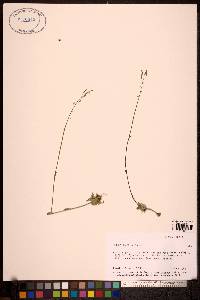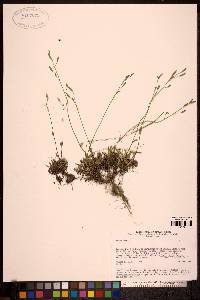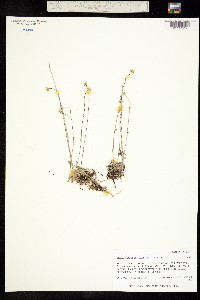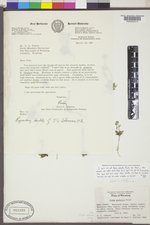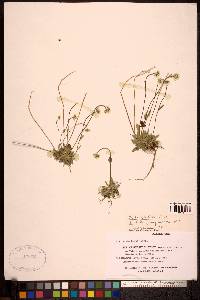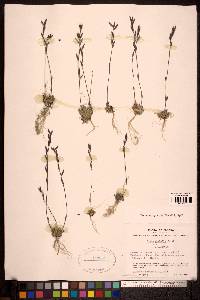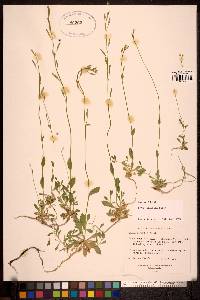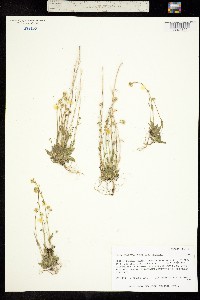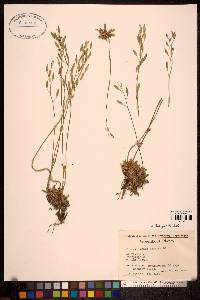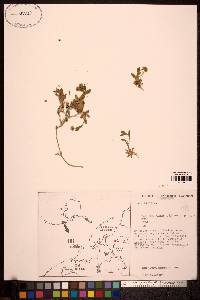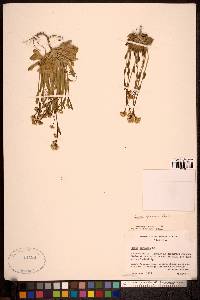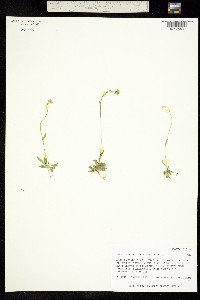Draba glabella
|
|
|
|
Family: Brassicaceae
Smooth Whitlow-Grass
[Draba canadensis Brunet, moreDraba glabella var. brachycarpa (Rupr.) Fernald, Draba glabella var. pycnosperma (Fernald & C.H. Knowlt.) C.H. Mulligan, Draba hirta var. brachycarpa Rupr., Draba hirta var. laurentiana (Fernald) B. Boivin, Draba hirta var. pycnosperma (Fernald & C.H. Knowlt.) B. Boivin, Draba johannis Host, Draba norvegica var. sornborgeri (Fernald) B. Boivin] |
Perennials; (sometimes cespitose); caudex simple or branched; not scapose. Stems branched or unbranched, (0.4-)1-3.5(-4.7) dm, often pubescent throughout (sometimes sparsely so distally), sometimes glabrous, trichomes simple and 2-rayed, (non-crisped), 0.2-1 mm, or subsessile, stellate-pectinate, and 3-8-rayed, 0.1-0.3 mm. Basal leaves rosulate; petiolate; petiole ciliate, (trichomes simple, 0.1-0.8 mm); blade oblanceolate to spatulate or linear-oblanceolate, (0.6-)1-3.5(-5) cm × 2-8(-10) mm, margins dentate or denticulate, (pubescent as petiole), surfaces pubescent with non-crisped, minutely stalked, 4-8(-12)-rayed, stellate-pectinate trichomes, 0.15-0.6 mm, (midvein obscure abaxially), adaxially sometimes also with simple trichomes, or glabrous. Cauline leaves 2-17(-25); sessile; blade ovate to oblong, margins dentate to subentire, surfaces often pubescent as basal, or predominantly with simple trichomes adaxially. Racemes (5-)8-26(-34)-flowered, ebracteate or proximalmost 1 or 2 flowers bracteate, elongated in fruit; rachis not flexuous, usually glabrous, rarely pubescent as stem. Fruiting pedicels divaricate-ascending to suberect, straight, (1-)3-10(-16) mm, glabrous or pubescent as stem. Flowers: sepals oblong, 2-3.5 mm, pubescent, (trichomes simple and short-stalked, 2-4-rayed); petals white, broadly obovate, 4-5.5 × 1.5-3 mm; anthers ovate, 0.3-0.5 mm. Fruits oblong to ovate or ovoid to lanceolate or linear-lanceolate, usually plane, rarely slightly twisted, flattened or inflated, (3-) 5-12(-16) × 2-3.5 mm; valves glabrous or pubescent, trichomes simple or 2-4-rayed, 0.05-0.2(-0.4) mm; ovules (20-)24-36 per ovary; style 0.05-0.2(-0.5) mm. Seeds oblong, 0.9-1.1 × 0.5-0.7 mm. 2n = 64, 80. Flowering May-Aug. Rock outcrops, talus, rocky ridges and knolls, meadows, tundra, gravelly beaches sandy river margins, disturbed soils; 0-1400 m; Greenland; B.C., Man., N.B., Nfld. and Labr., N.W.T., N.S., Nunavut, Ont., Que., Yukon; Alaska, Maine, Vt., Wis.; n Europe (n Russia); e Asia (Russian Far East, Siberia). Draba glabella was reported by J. V. Freudenstein and J. K. Marr (1986) from Michigan, but that record likely was based on plants of D. arabisans, a highly variable species that occurs in that state. Draba glabella is extremely variable in indumentum, number of cauline leaves, fruiting pedicel length, fruit shape and size, style length, and seed number. M. L. Fernald (1934) divided it into five species and three varieties; R. C. Rollins (1993) recognized three species. Of these, G. A. Mulligan (1970, 1976) reduced D. laurentiana to synonymy of D. glabella and treated D. pycnosperma as a variety. Of all the segregates of D. glabella, var. pycnosperma might merit recognition. It is restricted to northwestern Newfoundland and northeastern Quebec, where var. glabella also grows. The main difference between the two varieties is the presence in var. pycnosperma of plump (versus flattened), ovoid to oblong fruits. Draba sornborgeri, recognized by Rollins as a distinct species, is merely a glabrescent form of D. glabella. Because of the tremendous morphological variability, wide distribution, extensive synonymy, and different chromosome numbers, D. glabella will require extensive molecular, cytological, and morphological studies to properly delimit the species and any potential infraspecific taxa. Some forms of Draba glabella approach both D. borealis and D. praealta, but these can be distinguished by examining the trichomes on the abaxial surfaces of basal leaf blades. In D. glabella, these trichomes are minutely stalked or subsessile and have branched rays. In the other two species, the trichomes have long stalks and the rays are always unbranched. The Linnaean name Draba hirta was applied to this species previously, and still is in Russia. The name is not typified, and the material at LINN is in bad condition and probably belongs to two species, D. glabella and D. norvegica, as recognized here. A typification of D. hirta may necessitate its re-introduction for this species.
Much like no. 8 [Draba arabisans Michx.]; cauline lvs mostly obtuse or broadly rounded at base; frs glabrous or sparsely hirtellous, oblong or lance-oblong, 7-11 נ2-3.5 mm, mostly one-fourth to two-fifths as wide as long, straight or nearly so; persistent style 0.1-0.3 mm, or virtually obsolete; 2n=64, 80. Rocky or gravelly places and cliff-crevices; circumboreal, s. in our range to N.B., n. N.Y., and Isle Royale. May-July. Gleason, Henry A. & Cronquist, Arthur J. 1991. Manual of vascular plants of northeastern United States and adjacent Canada. lxxv + 910 pp. ©The New York Botanical Garden. All rights reserved. Used by permission. |

















